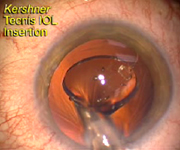©2005. Robert M. Kershner, MD, MS, FACS
Eye Laser Consulting
Boston, Massachusetts USA
IOL design has undergone tremendous advances in the last twenty years, since the late Sir Harold Ridley invented the first IOL in 1949 and benefited by his own invention fifty years later. Only recently has the optics of the IOL begun to change. The Tecnis™ IOL (Advanced Medical Optics, Santa Ana, CA USA) represents the first IOL that has a wavefront designed modified prolate anterior surface optic that neutralizes the positive spherical aberration of the human cornea (1). Spherical aberration is the single most significant aberration of the human optical system and it increases throughout life decreasing visual quality. Implantation of conventional spherical IOL optics not only fail to address this problem, but actually contribute to it. Implantation of the Tecnis™ IOL has been shown to significantly reduce spherical aberration in postoperative cataract patients (2). The FDA approved this lens for use in the USA in 2002.
Much of the undesirable optical side effects of any single optic bifocal IOL is due to spherical aberration. Using the highly successful and stable Tecnis platform, optical engineers added a diffractive multifocal optic to the posterior surface of the lens. The result is the modified prolate Tecnis™ Multifocal IOL.
The IOL is easily handled and injected into the eye using the AMO Silver Series II T IOL injector (3). To avoid potential problems with this style of IOL, surgeons should assure that the injector cartridge is well lubricated with either Healon or Vitrax, the IOL haptics are properly oriented along the 2 and 8 o’clock axis when positioned in the cartridge, the leading haptic is facing into the barrel of the cartridge and the trailing haptic is outside the rear of the cartridge. Should attention not be paid to proper loading of the IOL, there is a remote chance of haptic capture, destaking of the haptic or tearing of the lens optic. Should the IOL be torn or damaged during insertion, it should be completely removed.
The AMO Tecnis™ Multifocal IOL is not yet FDA approved for use in the US. It promises to be a successful addition to our efforts at restoring accommodation to the post cataract patient.
Dr. Kershner is President and CEO of Eye Laser Consulting in Boston, Massachusetts. He has no proprietary or financial interest in any device or technique mentioned in this article.
Figures
1. The Tecnis Multifocal IOL

2. Injection of the Tecnis IOL is simplified by the Silver Series Injection System
References
• Kershner RM. Retinal image contrast and functional visual performance with aspheric, silicone, and acrylic intraocular lenses. J Cataract Refract Surg . 2003;29:1684-1694.
• Mester U, Dillinger, P. Anterist, N. Impact of a modified optic design on visual function: Clinical Comparative Study. J Cataract Refract Surg . 2003;29(4):652-660.
• Kershner, RM “Tecnis IOL Adapts Well to Injector System” Ocular Surgery News , 22(21):4, 5-53, November 1, 2004.
